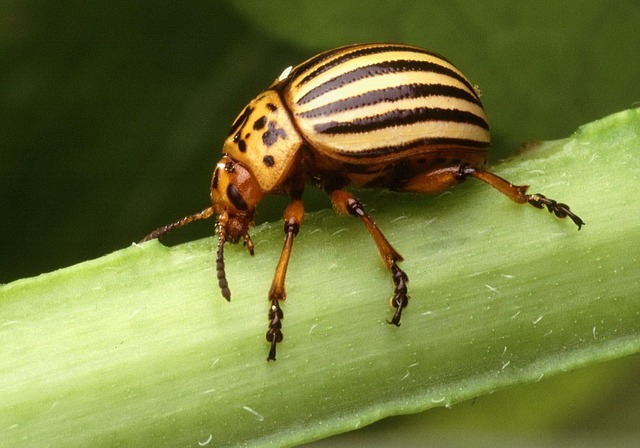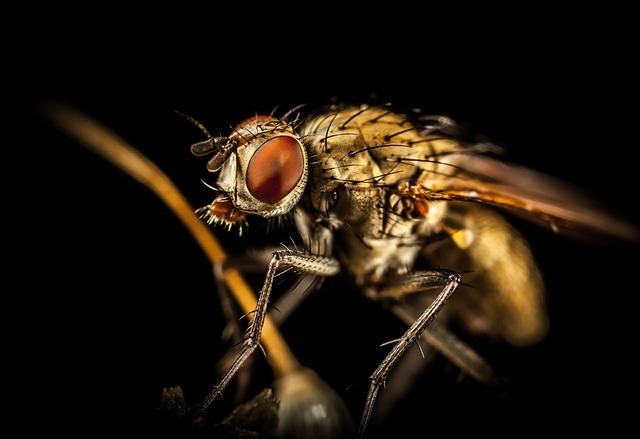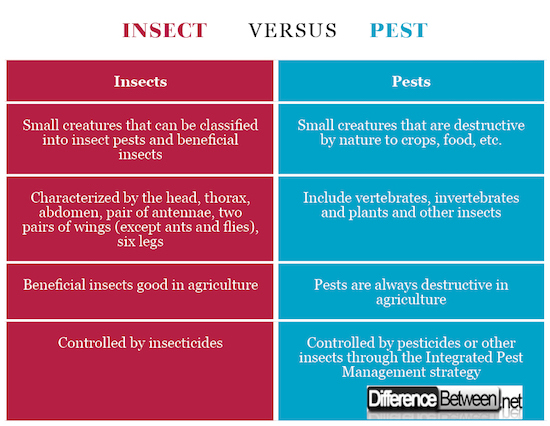Difference Between Pest and Insect
Insect and pest infestation can be a nuisance in households or gardens. There are, however, some beneficial insects that play a significant role in the ecosystem. They can stabilize the ecosystem and keep pests in control. On the other hand, pests are harmful to crops and to human beings. While these creatures share some similarities, they are often confused where people regard insects as pests, and vice versa. This article highlights the key difference between insects and pests.
What is an insect?
Historically, insects have existed millions of years prior to the emergence of human population. They have a significant role played on the ecosystem and one of the roles is to keep pests under control. Also, they fall under the family of arthropods. Some insects can be classified as pests due to their behaviors comparable to pets while others are classified as beneficial insects. Beneficial insects help farmers and gardeners with pollination where they can spread the seeds of flowers to other species to reproduce. In the absence of these beneficial insects such as the bees, gardeners would have to pollinate plants manually, which is of course a time consuming and an expensive method.
The insect is identified by its structure. Usually, insects are divided into the head, the thorax and the abdomen. They have a pair of antennae, six legs, and two pairs of wings although ants and flies are an exception in this description of wings. Examples of beneficial insects include honey bees, wasps, stink bugs, ladybugs and spiders. Generally, insects can live under adverse environmental conditions hence they are found in almost all parts of the world.
An infestation of insects is chemically controlled by using insecticides. Meanwhile, insect pests can be controlled by other insects of parasitic or predatory nature. For example, the coccinellidae and carabidae predatory groups and the hymenoptera parasitic group are used to control insects that are also pests. Entomology, a branch of Zoology, entails the study of insects and it has uncovered these characteristics of insects.
What is a pest?
A pest is a small destructive organism that usually attack crops, animals and food. Common examples of pests include cockroaches, mites, ticks, mosquitoes, bed bugs, lice, nematodes, plants, birds, thrips, and termites. In a farm or garden, pests can hinder the production of crops by destroying them and then lead to an economic loss. Farmers resort to potent pesticides to control pest infestations to keep them in control. However, potent chemical substances can be harmful to the air and to human health when they get absorbed into the crops.
Alternatively, farmers are advised to opt for the natural pest control measures which include biological pest control, traps and cultural practices. Pests are not only damaging to the crops but can cause diseases in humans or destroy electrical wires. When controlling pets, professional pest control companies utilize the Integrated Pest Management (IPM) strategy.
The Integrated Pest Management strategy is encouraged by agriculture departments around the world due to the benefits it brings compared to hazardous pesticides. The strategy is environmentally friendly, economical and effective in managing pests. It can integrate a cultural control, chemical control, physical and biological control. Compared with pesticides, the IPM improves food safety and health of consumers. Pests include vertebrates, plants and invertebrates.
Key difference between pest and an insect
Definition of Pest and Insect
Pests are small creatures, organisms that are notorious of destroying crops, food, causing diseases, and attacking livestock. Insects are also small creatures that can be classified into insect pests and beneficial insects. Insect pests are insects that can also be classified as pests whereas beneficial insects are those that improve crop production, keep pests under control and pollinate flowers.
Characteristics of Pest and Insect
Pests include vertebrates, plants and invertebrates. Insects belong to the arthropods and are characterized by the division into the head, thorax and the abdomen, and two pairs of wings (not all), pair of antennae, and 6 legs.
Control of Pest and Insect
Pests are often called by using pesticides. Alternative strategies include biological control where predatory insects can be introduced in a garden to feed on pests and keep them in control. This is an environmental and safe way to improve food safety and protect human health.
Insects are controlled used insecticides. Insect pests can be controlled using predatory and parasitic insects.
Effects in agriculture due to Pest and Insect
Pests are destructive in nature. They are continually looking for food to survive and to reproduce other pests. Pest infestation can be overly destructive to crop production, and can lead to diseases in humans. Insects, on the other hand, are beneficial in agriculture. Insects such as bees play a significant role in pollination. In the absence of bees, farmers will have to pollinate by hands and that is time consuming.
Pest Vs. Insect: Comparison Chart
Summary of Pest verses Insect
- Insects can be classified into insect pests and beneficial insects
- Pests are small organisms that are detrimental to crop production, cause diseases in human and attack livestock
- Insects are controlled by insecticides while pests are controlled by pesticides or other insects
- Insects help in pollination and in stabilizing the ecosystem. Bees, in particular, are used in pollination. Pests are not used in anything.
- Insects are identified by the head, thorax and abdomen; pair of antennae, pair wings and three pairs of legs whereas pests include plants, vertebrates and invertebrates.
- Difference Between CBD and Indica - April 22, 2019
- Difference Between Unilateral Contract and Bilateral Contract - February 8, 2019
- Difference Between Polki and Kundan - December 15, 2018
Search DifferenceBetween.net :
1 Comment
Leave a Response
References :
[0]Edible Schoolyard Pittsburgh (2012). Pests and Beneficial Insects. Retrieved from: http://schools.growpittsburgh.org/wp-content/uploads/2012/11/Identifying-Insects-2-Pests-and-Beneficials.pdf
[1]Hammond D. (2014). Heat Treatment for Insect Control: Developments and Applications. Elsevier, 18 Sep 2014.
[2]Lawrence A. Lacey (2016). Microbial Control of Insect and Mite Pests: From Theory to Practice. Academic Press, 03 Sep 2016
[3]Image credit: https://pixabay.com/en/insect-decemlineata-leptinotarsa-387179/
[4]Image credit: https://pixabay.com/en/insect-pest-fly-nature-macro-3067367/




Intellectual information.